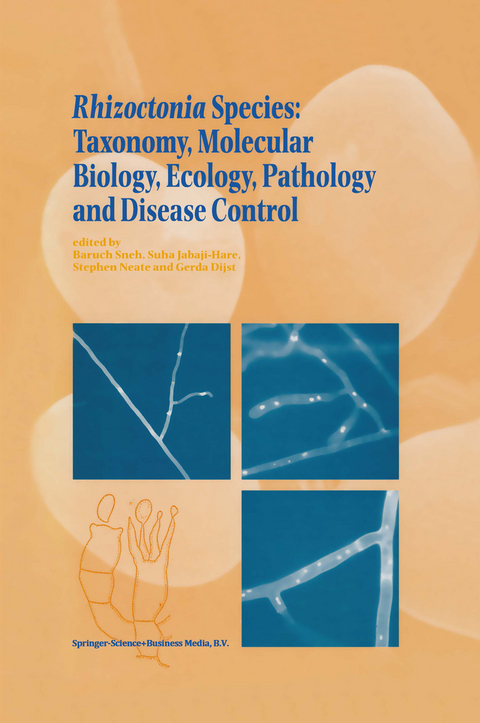
Rhizoctonia Species: Taxonomy, Molecular Biology, Ecology, Pathology and Disease Control
Springer (Verlag)
978-0-7923-3644-0 (ISBN)
The subject reviews covered in the book include classic as well as modern approaches to Rhizoctonia research in: Taxonomy and Evolution, Genetics and Pathogenicity, Plant-Rhizoctonia Interactions, Ecology, Population and Disease Dynamics, Disease Occurrence and Management in Various Crops, Cultural Control, Biological Control, Germplasm for Resistance, Chemical and Integrated Control Strategies. It aims to be the standard reference source book on Rhizoctonia for the next decade or more, just as Parmeter et al. (1970) has been in the past. It will be an important publication for Rhizoctonia investigators, plant pathologists, students, extension specialists, crop producers and companies dealing with plant disease control.
— The Genus Rhizoctonia.- I. A. 1. — The dolipore/parenthesome septum in modern taxonomy.- I. A. 2. — Grouping in Rhizoctonia solani by hyphal anastomosis interactions.- I. A. 3. — A synopsis of the taxonomy of teleomorphs connected with Rhizoctonia s. l..- I. B. 1. — Biochemical methods.- I. B. 2. — DNA base sequence complementary analyses.- I. B. 3. Molecular analysis of ribosomal RNA genes in Rhizoctonia fungi.- I. B. 4. — Integrated biochemical, cultural and numerical methods.- II. 1. — Genetics of Rhizoctonia species.- II. 2. — Translocation and transfer in Rhizoctonia: Mechanisms of significance.- II. 3. — Extrachromosomal elements and degree of pathogenicity in Rhizoctonia solani.- II. 4. — Culture preservation methods for maintaining genetic integrity of Rhizoctonia spp. isolates..- III. 1. — The initial steps of the infection process in Rhizoctonia solani.- III. 2. — Rhizoctoniasolani: Penetration, colonization and host response.- IV. 1. — Identification and detection of Rhizoctonia solani using serological and DNA marker techniques.- IV. 2. — Sampling and quantification of Rhizoctonia solani in soil.- IV. 3. — Basidiospore dispersal and survival.- IV. 4. — Sclerotia formation by Rhizoctonia species and their survival.- IV. 5. — Patch dynamics and bare patch.- IV. 6. — Mechanisms involved in disease decline.- IV. 7. — Analyzing crop losses due to Rhizoctonia solani: rice sheath blight, a case study.- V. 1. — Oilseed rape and canola diseases incited by Rhizoctonia species.- V. 2. — Characterization of Rhizoctonia isolates, disease occurrence and management in cereals.- V. 3. — Cotton diseases incited by Rhizoctoniasolani.- V. 4. — Flowerbulbs diseases incited by Rhizoctonia species.- V. 5. — Forage and oil seedlegume diseases incited by Rhizoctonia species.- V. 6. — Ornamental diseases incited by Rhizoctonia spp..- V. 7. — Peanut diseases incited by Rhizoctonia species.- V. 8. — Rhizoctonia disease on Potato.- V. 9. — Rice diseases incited by Rhizoctonia species.- V. 10. — Sugar beet diseases incited by Rhizoctonia species.- V. 11. — Rhizoctonia associated with forest trees.- V. 12. — Biology of turfgrass diseases incited by Rhizoctonia species.- V. 13. — Vegetable diseases incited by Rhizoctonia spp..- V. 14. — The mycorrhizal species of Rhizoctonia.- V. 15 — Photographs of symptoms icited by Rhizoctonia spp. on various crops.- VI. A. 1. — Cultural methods and soil nutrient status in low and high input cropping systems as they affects Rhizoctonia species..- VI. A. 2. — Soil solarization for the control of diseases caused by Rhizoctonia spp..- VI. A. 3. — Suppressive soil amendments for the control of Rhizoctonia species.- VI. B. 1. — Antibiotic and siderophore producing bacteria.- VI. B. 2. — Bacterial and fungal cell-wall hydrolytic enzymes in relation to biological control of Rhizoctonia solani.- VI. B. 3. — Actinomycetes, cyanobacteria and algae.- VI. B. 4. — Non pathogenic isolates of Rhizoctonia (np-R) spp. and their role in biological control.- VI. B. 5. — Mycoparasitism and biocontrol.- VI. B. 6. — Role of the fauna in biological control of Rhizoctonia.- VI. B. 7. — Introduced biocontrol agents to suppress diseases caused by Rhizoctonia.- VI. C. 1. — Availability of germplasm for resistance against Rhizctonoia spp..- VI. C. 2. — Strategies for molecular resistance breeding (& transgenic plants).- VI. D. — Chemical Control of Rhizoctonia species.- VI. E. — Integrated control of Rhizoctonia species.
| Erscheint lt. Verlag | 30.9.1996 |
|---|---|
| Zusatzinfo | XVI, 578 p. |
| Verlagsort | Dordrecht |
| Sprache | englisch |
| Maße | 155 x 235 mm |
| Themenwelt | Naturwissenschaften ► Biologie ► Botanik |
| Naturwissenschaften ► Biologie ► Mykologie | |
| ISBN-10 | 0-7923-3644-5 / 0792336445 |
| ISBN-13 | 978-0-7923-3644-0 / 9780792336440 |
| Zustand | Neuware |
| Informationen gemäß Produktsicherheitsverordnung (GPSR) | |
| Haben Sie eine Frage zum Produkt? |
aus dem Bereich


